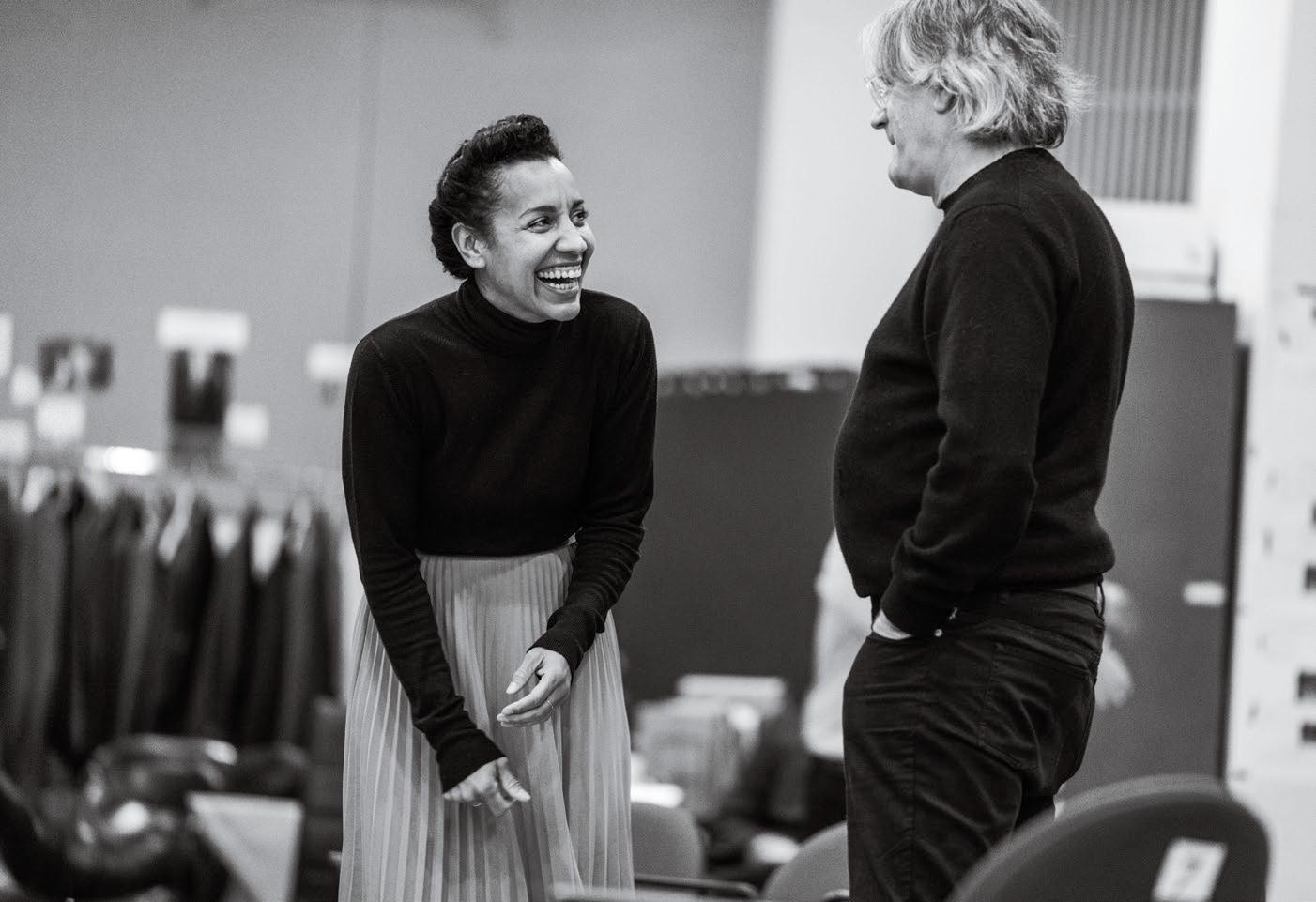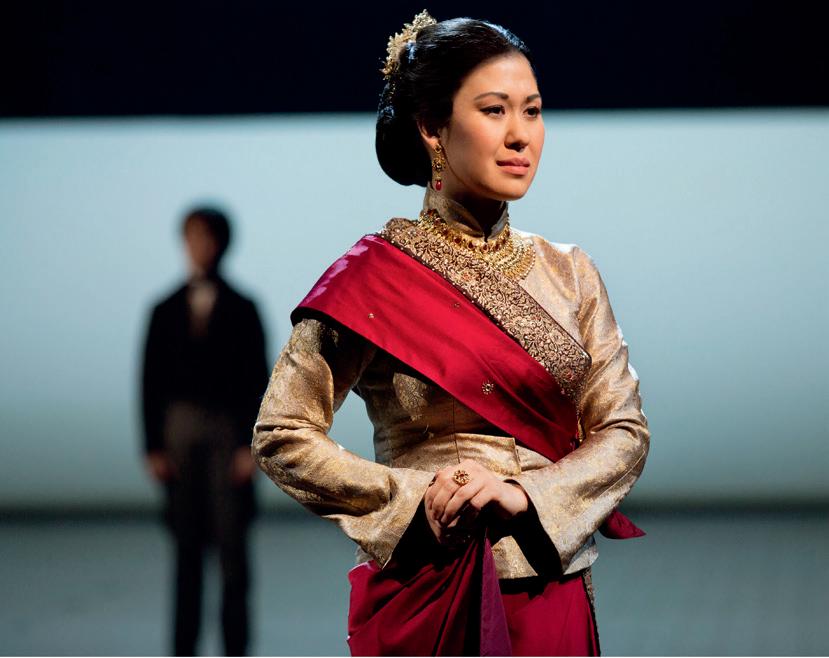
6 minute read
A SINGULAR SPACE
BARTLETT SHER
HALFWAY THROUGH THE SECOND ACT of The Light in the Piazza, a distressed Clara Johnson faced the greatest dilemma of her life when she overheard her mother on the phone with her father revealing a secret kept from young Clara about her accident as a young child. The news struck her with a truth about her injury and disability that was painful, damaging, and irrevocable. Until now, the theater had been filled with the great piazzas and streets of Florence, but the light she had previously sung about in the first act was now wholly different. In an instant, the set opened up to a vast, empty space dominated by a giant cyclorama as young Clara, in a white wedding dress, raced through the flooding light in a swell of music and flung herself in despair onto the stage with a profound open cadenza of anguish—completely alone and in the grips of damaging and profound truth.
It was heartbreaking theater that could only have happened in the exceptional embrace of the Vivian Beaumont.
As a director, I have been fortunate to work in some of the greatest theaters in the world from La Scala in Milan, to the Sydney Opera House, to the Festspielhaus in Salzburg, to Japan and the West End and Broadway and the Metropolitan Opera and all over the United States, but none of these houses for me compare with what is possible for making theater at the Vivian Beaumont Theater at Lincoln Center.

What makes the Beaumont so special is its unique qualities as a thrust theater and the profound relationship it has to its audience, one unlike anywhere on Broadway. Almost all Broadway theaters are proscenium houses like a movie theater where an audience sits on one side and the action takes place opposite within the frame of the proscenium. This provides the audience with a shared and single relationship to the play or musical. But the Beaumont is a severe thrust which comes three quarters into the audience and is itself supported by a huge upstage playing space.

Audiences at the Beaumont surround the action on three sides. This creates a deeply intimate relationship of the audience to actors and even though the house is a large one, no audience member is more than forty feet from the stage. At the same time, the house then shifts the single point of view that an audience experiences in a proscenium to fully 1,100 different points of view. Every single audience member is seeing a different show. This creates incredible challenges for a director who now must stage elegantly and carefully from all sides.
In addition, the Beaumont has the largest stage footprint in all of Broadway and is the only stage width that equals the Metropolitan Opera, not to mention enormous offstage space for scene storage. This allows for an incredible variety of epic scenic designs. When I directed The King and I, the boat that Anna and her son arrived into the harbor in Bangkok was fully thirty-seven feet long and travelled over a hundred feet on its journey, but more impressive was how easily it was stored offstage. These are realities unseen by an audience but exceptional for a creative team.
As a result, the Beaumont has the most magnificent relationship of epic to intimate perhaps anywhere in the world. The audience gets the benefit of unparalleled intimacy with actors who are often only feet away while the mise-en-scène of the design can be simply magnificent in scale. Anyone lucky enough to see Peter Brook’s Carmen or Patti LuPone in Anything Goes or Sam Waterston in Abe Lincoln in Illinois or Victoria Clark in The Light in the Piazza or Kelli O’Hara in South Pacific have been overwhelmed by the singular power of one of the greatest spaces in the world where an audience can be so close to a performance and simultaneously so swept up in the experience.
As directors, actors, and designers we underestimate how important a great theater space can be. It lifts us. It speaks to us and challenges us. It pushes us to try things we never thought we could accomplish and it stretches us to the end of our abilities and makes us take the greatest risks. A playwright who can write for the Beaumont or a director who can move and shape scenes upon its boards or a designer who can fill it with a set or light or clothes or an actor who can push a thought throughout the room, all of this is what we long for in our work. And the Vivian Beaumont is one of the greatest of our great houses of storytelling. It has made us all better. And audiences who enter the circle of culture as they arrive at Lincoln Center expect the most of us when they arrive at the Beaumont.
But the hardest job of all is to produce great theater here. And in that way, André Bishop has been the most elegant and insightful guide of all. His understanding of what is possible here and his bravery in programming while supporting artists to thrive is unparalleled. No one else would have had the courage to produce The Coast of Utopia and given Jack O’Brien the support to pull off an extraordinary achievement. The pure breadth and scope of Utopia was unmatched on a Broadway stage, and it took the bravery of a great producer to be bold enough to do it. Because while the Beaumont challenges us, we also need great producers like André (and Bernie Gersten) to bring ideas and work to it that lifts us all and makes us understand the limitlessness of great theater.
Forty years is a very short time to celebrate a room that has such poetic and perfect qualities. But happily, we celebrate the forty years and more ahead as theater is made that will help us experience joy, confront complexity, and see the world in new ways together. And perhaps this great space will even guide us to a better place for our children and for the great cultural place we have come to love within its glorious walls. We need it now more than ever. ▪
Header Photo: Kelli O'Hara in The Light In the Piazza. Copyright: Joan Marcus.










